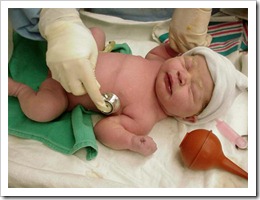- Last Updated
- Posted by
- Childbirth, Pain Control
Some References & Research
 First of all, a handful of very early references to the use of hypnosis for childbirth, courtesy of Albert Moll, probably the best-known German hypnotist of the 19th century,
First of all, a handful of very early references to the use of hypnosis for childbirth, courtesy of Albert Moll, probably the best-known German hypnotist of the 19th century,
The value of hypnotism in obstetrics is about the same as in surgery. Lafontaine and Fillassier among the mesmerists have put women to sleep during labour. Liebault has done the same with hypnotism. A series of such cases has lately been published (Pritzl, Mesnet, Secheyron, Auvard, Thomas, Varnier, Voigt, De Jong). The effects were not unfavourable. The pains were regular and strong, and could often be made almost insensible by suggestion. (Moll, Hypnotism, 1890, p. 330)
Almost a century later, Crasilneck & Hall provided a review of hypnosis for obstetrics in their well-regarded clinical textbook, Clinical Hypnosis: Principles and Applications (1975). They quote the noted obstetrician DeLee, who wrote: “the only anaesthetic that is without danger is hypnotism” and mention the following reports of hypnosis being used,
Hypnosis has been found by many to significantly increase the ease and speed of labor and to decrease anxiety and discomfort (Baer, 1957; Carter, 1963; Cheek & LeCron, 1968; Corley, 1963; Hartman & Rawlins, 1960; Hoffman & Kopenhauer, 1961; Kohl, 1962; Kroger, 1963a; Werner, 1965). Many other psychological techniques used in facilitating ease of childbirth are derived from hypnosis (Vellay, 1964), even in Russia (Nikolayev, 1954). (Crasilneck & Hall, 1975 p. 254)
Elsewhere they add,
Some obstetricians use group classes in hypnosis prior to delivery (Malyska and Christensen, 1967), while others feel that individual training is preferable (Mosconi, 1966). We agree with the latter. (Crasilneck & Hall, 1975 p. 255)
They also mention,
Others who have verified the usefulness of hypnosis in delivery include Chertok (1959, 1963), Clark (1956), Collison (1974), Hoffman and Kopenhauer (1961), Kroger (1962), Oystragh (1970), and Zuspan (1960, 1973). Coulton (1966) has discussed its use in postpartum problems. (Crasilneck & Hall, 1975 p. 256)
They describe a small controlled experiment on hypnotherapy used to alleviate pain and other problems associated with childbirth, in which the hypnotist was a different person from the physician performing the delivery,
Pascatto and Mead (1967) in a series of 25 patients showed that those in the experimental group (10) who received hypnosis had a significant reduction of sedation during delivery and less postpartum insomnia, headache, and breast discomfort as compared to the control group. (Crasilneck & Hall, 1975 p. 255)
They add,
The lessening of chemical anaesthesia may be of benefit to the infant as well as to the mother. Moya and James (1960) found the Apgar test (a measurement of the well-being of the infant one minute after birth) to be better in a group of infants delivered under hypnosis than in a group whose mothers received cyclopropane anaesthesia. The scores of the infants delivered under hypnosis were similar to those whose mothers had regional anaesthesia, such as spinal or caudal blocks. (Crasilneck & Hall, 1975 p. 255)
They provide a brief review of the following studies,
August (1960) attempted hypnoanaesthesia in 351 of 442 expectant mothers, finding it successful as the sole analgesic agent for 328 (93.5 percent); in another study (1961) 58 percent of those who underwent hypnosis required no chemical analgesic. Mody (1960) reported 20 patients with an average success rate of 75 percent. In his study “there appeared to be no relationship between the extent of relief of pain and the number of sittings or the depth of hypnosis.” Mosconi and Starcich (1961) reported 100 obstetrical cases using hypnotic analgesia. They secured excellent results in 79 percent. Tom (1961) and Werner (1963) have noted the usefulness of hypnosis in decreasing the pain associated with labor and delivery. Kline and Guze (1955) employed self-hypnosis with 30 obstetrics patients who were seen once a week for an eight-week period, averaging 30 to 30 minutes at each visit. At subsequent delivery, 57 percent required no drugs, 17 percent had less than average drug dosage, 23 percent had average dosage, and 3 percent required more than average dosage. (Crasilneck & Hall, 1975 p. 255-256)
They also report the following use of hypnosis to treat hyperemesis, or vomiting, in pregnancy,
One of the common and most difficult problems in the first trimester of pregnancy is hyperemesis, excessive vomiting that may occur early in pregnancy and may progress to the point of dehydration, hospitalization, and even loss of the foetus. Successful hypnotic treatment of 28 women with this problem, all of whom had not responded well to other methods, was reported by Fuchs, Brandes, and Peretz (1967). (Crasilneck & Hall, 1975 p. 254)
They review several studies that replicate the earlier large-scale findings of Soviet researchers, showing that the duration of labour is substantial shortened in women receiving hypnosis,
Abramson and Heron (1950) have reported a statistically significant difference in length of labor between a group of 88 women who had no hypnosis and 100 women who were trained with hypnosis before delivery. During the first stage of labor, the longest of three stages, the cervix is slowly effaced and dilated so that the baby may pass through. This is usually the most exhausting stage of delivery, particularly in women who are delivering their first baby. Abramson and Heron found that this stage of labor was shortened by an average of 3.23 hours in those women trained with hypnosis, a difference that would occur by chance only three times in a hundred. In women delivering their second or later baby, the times of the first stage was 1.79 hours shorter for the hypnotic group, again statistically significant at the level of p=0.04. Callan (1961) found that hypnosis reduced the average duration of labor in primiparas by 3.7 hours and by 5 hours in multigravidas. Mellgren (1966) found an overall reduction of labor by 2 to 3 hours. Autohypnosis has also been reported to shorten the first stage of labor (Davidson, 1962). (Crasilneck & Hall, 1975 p. 256)
They provide the following curious report,
A very dramatic demonstration of the effect of hypnosis on labor was reported by Rodriguez and his colleagues (1954). They attached a device called an “external tokodynamometer” to the abdominal wall of a young woman in her first labor. While the machine recorded the frequency and strength of contractions, hypnosis was alternately induced and removed. Their tracings show the striking way in which the induction of hypnosis caused an immediate change in the contractions, which became much more regular and forceful, the kind of contractions that are effective in facilitating labor. When the hypnotic trance was terminated, the contractions once more became irregular, but they would resume the regular pattern when hypnosis was again induced. Hartland and Mills (1964) have emphasised that hypnosis may be so facilitating that labor may progress faster than seems evident from the patient’s reactions. (Crasilneck & Hall, 1975 p. 255)
They go on to provide more specific examples of the application of hypnosis to obstetrics from the literature, quoting several reports in greater detail.

